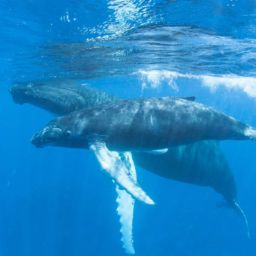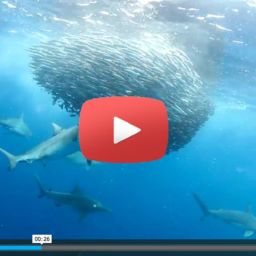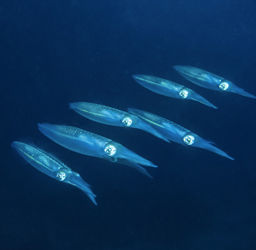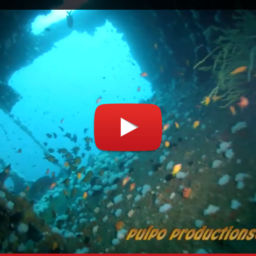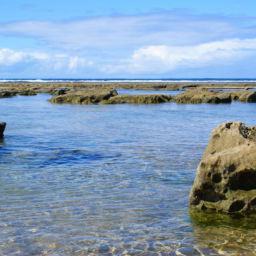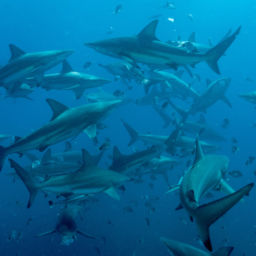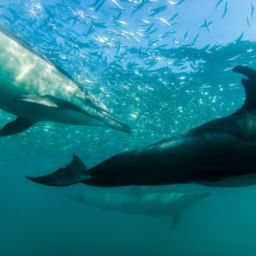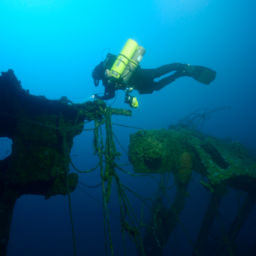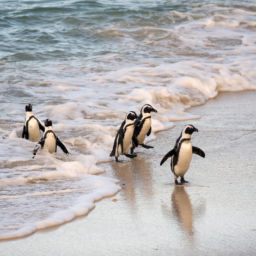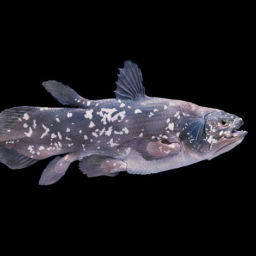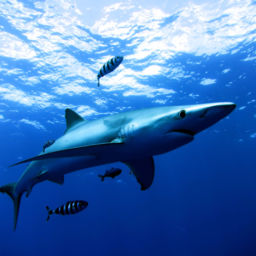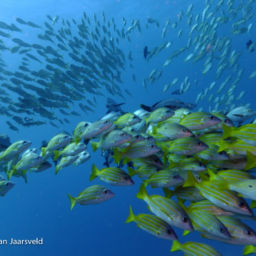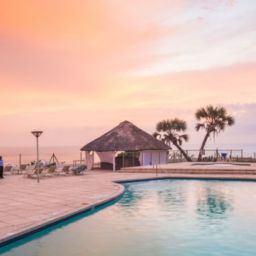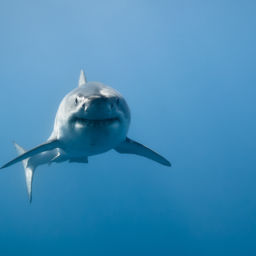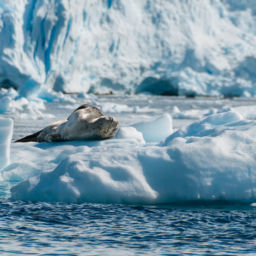In the third of our six-part series on the world’s most dive-able wrecks we’re highlighting the best wreck diving in Africa, focusing on southern and eastern Africa. (Check out Asia’s best wrecks here and the best wrecks in the United States here).
With more than 2,500 shipwrecks along the coast of South Africa and Cape Town sometimes called ‘The Graveyard of Ships,’ Southern Africa offers wreck-diving galore. Here are our picks for some of the best — and sometimes lesser known — wrecks in Africa.
The SS Maori
Where: Hout Bay (Kronkelberg), South Africa
The Maori, which went down in August 1909, is one of the oldest wreck-diving sites in Cape Town. Shortly after midnight, the ship slammed into some rocks and the hull split open. It lays on a rocky reef and is about 400 feet (122 m) long. Among other things, divers can see the railway lines that the vessel was carrying when it sank, as well as bits of porcelain and bottles. The ship was also carrying explosives, sewing machines, water piping and musical instruments when it sank. Divers can see much of this scattered around the wreck. Properly qualified divers can penetrate the wreck with the appropriate qualifications.
The wreck lays between 42 and 82 feet (13 to 25 m) in water ranging from 57 F (12 C) in July to around 64 F (18 C) in January. There can be strong currents and/or surge and poor visibility. This, combined with the cool water temperatures, makes this dive best for experienced divers.
The Paquita
Where: Knysna Heads, South Africa
The Paquita, a German iron barge, went down in 1903 and remains in excellent condition, with its iron plates still intact and anchors clearly visible. The wreck is covered in soft coral and divers can see many nudibranchs, blacktails, Cape stumpnoses and the famous Knysna seahorses.
The wreck lays between 6.5 and 65 feet (2 and 20 m) with an average depth of 40 feet (12 m). The best time to dive the Paquita is before the turn of high-tide when the water is clearer. You should not dive the wreck during mid-tide as the current can run up to 9 knots. Water temperature ranges from 62 F (16 C) in July to 69 F (20 C) in January.
The Produce
Where: Durban, South Africa
The Produce went down in 1974 after striking Aliwal Shoal. The vessel was 390 feet (119 m) long but the wreck now lays in three pieces on its starboard side. The stern is the largest, with the bow located about 65 feet (20 m) north and the mid-section in between. Qualified divers can penetrate both the bow and stern. Divers can see the spare prop, giant brindle bass (known as giant grouper elsewhere), Harlequin goldies (endemic to the Durban coastline) and sometimes even passing mantas.
The Produce lays between 50 and 100 feet (16 and 33 m) in water that ranges between 66 F (19 C) from July to October to 75 F (24 C) in February. There can be strong currents and bad visibility and no natural light penetrates the inside of the wreck. All of this combined with the depth, makes this a dive for experienced divers with deep and wreck qualifications.
The Klipfontein
Where: Zavora, Mozambique
The Klipfontein sank off the coast of Mozambique after hitting a reef in Zavora in 1953. The vessel was 525 feet (160 m) long but broke in two when it sank. Lucky divers can see humpback whales between July and October with August and September being peak season. Peak manta season is between November and March.
The Klipfontein is a deep to technical dive, lying between 111 to 170 feet (34 and 52 m) in water that ranges from 68 to 78 F (20 to 26 C). Advanced nitrox and technical divers with a recognized decompression-diving qualification (minimum 148 feet/45 m) can do this dive.
Rio Saiñas (also spelled Sainos)
Where: Zavora, Mozambique
The Rio Saiñas only sank in 2013 but already features copious coral growth. The purpose-scuttled wreck is fully intact with a large resident brindle bass (giant grouper), scorpionfish, schools of batfish and lots of nudis. Humpback pass through from July and October with August and September being peak season. Peak manta season is between November and March.
The Rio Saiñas sits upright between 65 to 114 feet (20 to 35 m) in water that ranges from 68 to 78 F (20 to 26 C), making it perfect for advanced divers.
SS Paraportiani
Where: Pemba Island, Zanzibar
The SS Paraportiani was a 328-foot-long (100 m) cargo vessel that sank in 1967. The stern is mostly still intact and covered in coral. Divers can see lionfish, anemones, yellowspotted scorpionfish and starfish. Qualified divers can penetrate the wreck.
The SS Paraportiani lies between 50 to 65 feet (15 to 20 m) in water ranging from 78 to 82 F (25 to 29 C). There can be strong currents at times, making this site a bit trickier to dive.
Ennerdale

Where: Mahé, the Seychelles
The Ennerdale sank in 1970 after striking two uncharted granite pinnacles off Mahé Island. This former British oil tanker is surrounded by an abundance of tropical fish and marine life including leopard rays, nurse sharks and whale sharks if you’re lucky. The stern is mostly intact, and divers can see the bronze propeller and the pilot house. The wreck also offers easy penetration.
The Ennerdale lies between 65 and 100 feet (20 and 30 m), making it an ideal dive for advanced divers. The water temperature ranges from 78 to 86 F (26 to 30 C).
Djabeda
Where: Coin de Mire (Gunner’s coin) Island, Mauritius
The Djabeda wreck is a Japanese fishing boat that sank in 1998. The wreck is well-preserved, but some debris is scattered around the vessel — the anchor is especially impressive. Hard and soft coral covers the wreck, and an abundance of marine life, including leaffish and sea slugs abound. Lucky divers may even encounter dolphins.
The wreck lies between 78 to 115 feet (24 to 35 m) and is best for advanced divers. Water temperature ranges from 75 to 82 F (24 to 28 C).
Stella Maru
Where: Mauritius
The Stella Maru is a Japanese trawler scuttled in 1987 to create an artificial reef. It sits upright and is almost completely intact. The wreck is covered in algae, sea urchins and soft coral and is surrounded by marine life. Divers can also explore a rocky reef nearby.
The Stella Maru sits between (20 to 27 m) in water that ranges from 62 to 82 F (20 to 28 C).
Mitsio
Where: Nosy Be, Madagascar
The Mitsio was a Madagascan trawler that was scuttled in 2006 as an artificial reef. The wreck is now covered in colorful coral and features plentiful lionfish, arrow crabs and honeycomb moray eels. The Mitsio makes for a great night dive for divers with the appropriate qualifications. Penetration is not recommended at night.
The Mitsio lies between 62 to 92 feet (19 and 28 m) in water that ranges from 79 to 84 F (26 to 29 C). Although there is usually little to no current, the depth of the wreck makes this an advanced dive.



